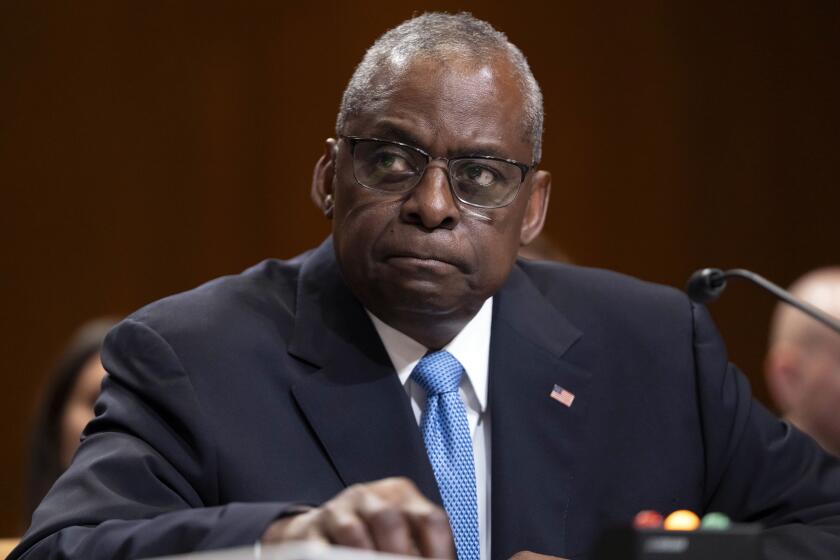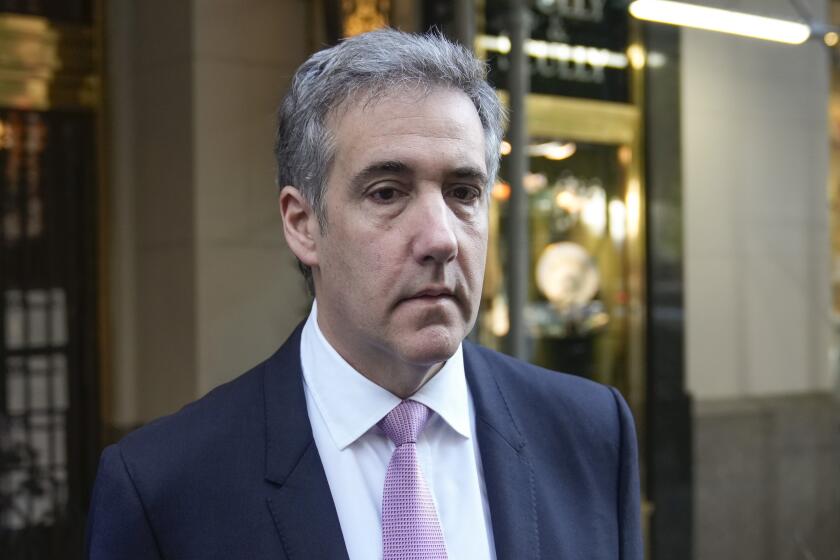Supreme Court Legal Titan Brennan Dies
Retired Supreme Court Justice William J. Brennan Jr., one of the legal giants of the 20th century and the architect of rulings that expanded civil rights, the freedom of speech and the right to abortion, died Thursday at age 91.
After a 34-year career on the high court, Brennan stepped down in 1990 after suffering a slight stroke. He had recovered slowly from a broken hip last November and died in a nursing home in suburban Arlington, Va.
President Clinton called Brennan “one of the finest and most influential jurists in our nation’s history” and “the staunchest, most effective defender of individual freedom.”
“America has lost a great justice,” said Atty. Gen. Janet Reno. “Justice Brennan stood up for people who had no voice. He devoted his long, rich life to helping the American justice system live up to its ideals.”
California Supreme Court Justice Stanley Mosk called Brennan “the greatest Supreme Court justice in modern times.”
Though largely unknown to the public, Brennan had an extraordinary influence on the law. He brought both intellectual power and personal charm to the task.
He fiercely believed in the idea that the Constitution was intended to protect the dignity of all persons, no matter what their rank or standing. Through more than 1,200 opinions over three decades, he wrote that principle into the law.
He also had a warmth and sunny disposition that often won over his far more conservative colleagues. Unlike other renowned liberals such as short-tempered William O. Douglas or cranky Thurgood Marshall, Brennan was a beloved figure at the court.
With twinkling eyes and a gentle, two-fisted handshake, Brennan resembled a little leprechaun who took delight in everyone he met. Janitors and secretaries at the high court said the justice recalled their sons and daughters and grandsons and granddaughters. Law clerks became part of his extended family too.
But his Irish charm had its greatest impact in the small circle of nine justices. Brennan understood the politics of the court and played them better than anyone had before--or anyone has since.
What’s the most important rule in the Supreme Court? he would ask his clerks. Holding up his hand, fingers outstretched, he then explained the “rule of 5.”
“It takes five votes to do anything around here,” he would say. Over many years, Brennan astounded lawyers and court observers with his skill in putting together five-vote majorities.
His success defied all conventional wisdom. Beginning in 1969, Republican presidents Nixon, Ford and Reagan sent a procession of new, conservative appointees to the high court, seven in all. Yet, the presidents and their legal advisors often watched in frustration as the new justices were won over to Brennan’s style of liberalism.
Conservative legal scholars sharply criticized Brennan as a “judicial activist” who wielded too much power and ignored the history of the 18th century Constitution, but they could not ignore his impact.
Indeed, at the height of the Reagan era, two conservative lawyers for his administration paid a grudging tribute to the sweeping changes wrought by the court’s guiding liberal. “There is no individual in this country, on or off the court, who has had a more sustained impact on public policy in the United States for the past 27 years,” they wrote of Brennan in a 1984 National Review magazine article.
Throughout Brennan’s career, he championed the underdog and insisted that the Bill of Rights protected the rights of all individuals, whether convicted murderers, flag burners or religious extremists. He wrote opinions defending the rights of the poor, immigrants, death row inmates, political protesters, welfare recipients, blacks who had been denied jobs and whites who had been fired from jobs.
During the 1960s, Brennan helped lead the legal revolution that made the Constitution a reality in everyday American life.
Until the 1950s, the Bill of Rights stood mostly as set of ideals, and its provisions limited only the federal government. For example, if an FBI agent broke into a home without a search warrant, he could be charged with violating the homeowner’s 4th Amendment right against “unreasonable searches and seizures.” But that limitation was not applied to local deputies or state troopers.
In 1961, however, the Supreme Court changed direction and ruled that the 4th Amendment applies to all public officials. That decision in Mapp vs. Ohio triggered a series of rulings that extended the legal protections in the Bill of Rights, such as the right to a lawyer and protections against forced self-incrimination or “cruel and unusual punishments.”
Until 1962, most state legislatures were controlled by rural areas. A sparsely populated county in Northern California had the same vote in the state Senate as Los Angeles County. But that year, Brennan helped establish what became the “one person, one vote” rule, which reshaped political power around the nation.
Until 1964, the 1st Amendment did not protect newspapers and other media from damaging libel verdicts in state courts. An Alabama jury had awarded a local sheriff a $500,000 damage verdict against the New York Times because an advertisement paid for by the NAACP was deemed to be critical of the sheriff.
Reversing that decision in the landmark New York Times vs. Sullivan ruling, Brennan helped extend the freedom of the press to limit state libel verdicts, and said the 1st Amendment was intended to encourage “uninhibited, robust and wide-open” debate in America.
He had joined the court soon after the 1954 Brown vs. Board of Education decision declared segregation unconstitutional, but Brennan wrote key opinions in the years afterward that put that principle into practice. A 1968 Brennan opinion said once-segregated school districts had an “affirmative duty” to desegregate their classrooms. That statement led to court-ordered busing--and bitter controversy--in many cities around the nation.
In the 1970s, he led the successful move to outlaw sex discrimination and to strengthen women’s rights. He also led the effort to permit affirmative action for minorities in colleges and workplaces.
His 1972 opinion striking down a Massachusetts law that banned the sale of contraceptives paved the way for the Roe vs. Wade ruling on abortion the following year.
“If the right to privacy means anything,” Brennan wrote, “it is the right of the individual, married or single, to be free from unwanted governmental intrusions into matters so fundamentally affecting a person as whether to bear or beget a child.”
In 1982, he wrote the 5-4 opinion that gave the children of illegal immigrants the right to attend public schools in Texas.
Near the end of his career, Brennan provoked an uproar in 1989 with his opinion for a 5-4 majority striking down the conviction of a political protester who burned a U.S. flag.
“If there is a bedrock principle underlying the 1st Amendment, it is that the government may not prohibit the expression of an idea simply because society finds the idea offensive or disagreeable,” Brennan wrote.
“I had no idea that it [the flag-burning decision] would cause so much controversy,” he commented a few months after the decision. One of his neighbors in his apartment complex responded by putting a flag on Brennan’s door, he noted with bemusement.
Brennan had his share of failures too. An avowed opponent of the death penalty, he joined with fellow liberals in 1972 to strike down all of the nation’s capital punishment laws.
But four years later, a reconstituted court upheld new death penalty laws. In his last years on the bench, Brennan and Marshall dissented alone as the court routinely affirmed death sentences.
Over the years, Brennan trampled on many toes, including those of police officials, state prosecutors and religious leaders. Although a devout Catholic, he voted to strike down official prayers in the public schools, opposed state aid to parochial schools and--more controversially--insisted that women had an absolute right to choose abortion.
But Brennan insisted that his first duty was to uphold the Constitution, regardless of what controversy might follow.
He was born William Joseph Brennan Jr. on April 25, 1906, the second of eight children in an Irish-Catholic family in Newark, N.J. His father, an Irish immigrant, worked first as a stoker of the fires at a local brewery, but rose to become a prominent labor leader and a member of the City Council.
Young Brennan graduated from the University of Pennsylvania in 1928 and from Harvard Law School in 1931, beginning his law practice during the Depression. After a decade in private practice and service in the Army, he was appointed a state judge and moved up to the New Jersey Supreme Court.
In late September 1956, the 50-year-old jurist was asked to come to Washington, ostensibly to discuss a recent speech on streamlining the courts. To his surprise, Republican President Dwight D. Eisenhower had decided to appoint Brennan, a Democrat, to fill a vacancy on the U.S. Supreme Court.
In the midst of the presidential campaign, the nomination drew little notice. Time magazine mentioned it in a small box entitled: “A Happy Irishman.”
The new justice dampened expectations too, comparing himself “to the mule entered in the Kentucky Derby. I don’t expect to distinguish myself, but I do expect to benefit from the association,” he said.
His prediction aside, Brennan soon distinguished himself. Of his first decade, Chief Justice Earl Warren commented of Brennan: “In the entire history of the court, it would be difficult to name another justice who wrote more important opinions.”
“His impact on the law was simply monumental,” said Harvard University law professor Laurence H. Tribe.
Long after the heyday of the Warren Court, Brennan continued to lead the liberal wing. In the 1970s and 1980s, he forestalled conservative attempts to roll back the civil rights, 1st Amendment and criminal-law rulings of the earlier time.
Brennan “fought one of the greatest rear-guard actions in history,” said University of Michigan law professor Yale Kamisar.
In a 1985 speech, Brennan forcefully countered conservatives who had called for the justices to shun current controversies and instead rely on the “original intent” of the 200-year-old Constitution.
“The genius of the Constitution rests not in any static meaning it might have had in a world that is dead and gone, but in the adaptability of its great principles to cope with current problems and current needs,” he said. “The Constitution will endure as a vital charter of human liberty as long as there are those with the courage to defend it, the vision to interpret it and the fidelity to live by it.”
Though Brennan’s power waned as Reagan’s appointees took their seats, he never ceased being an influential and surprisingly effective justice.
On June 27, 1990, in what proved to be his last day on the bench, the 84-year-old Brennan, speaking in a graveled voice, spoke for a 5-4 majority that upheld federal affirmative action rules in government contracting.
Three weeks later, the aging justice collapsed in the Newark Airport and was forced to cancel a cruise ship vacation. In a note to President Bush, he said he could no longer keep up with “the strenuous demands of court work,” but hoped his decisions expanding the Bill of Rights would survive.
“This legacy can and will withstand the test of time,” he wrote.
Not only has his legal legacy lived on, so too has his spirit in some of his colleagues, most notably David H. Souter, the justice who succeeded him.
The two became fast friends during Brennan’s last years, and the younger justice’s fondness and admiration for Brennan was unmistakable.
At a 1992 luncheon honoring the frail, retired justice, tears welled in Souter’s eyes as his spoke. “Quite simply, Justice Brennan is a man who loves. The Brennan mind,” he said, “met its perfect match in the Brennan heart.”
More to Read
Get the L.A. Times Politics newsletter
Deeply reported insights into legislation, politics and policy from Sacramento, Washington and beyond. In your inbox three times per week.
You may occasionally receive promotional content from the Los Angeles Times.







